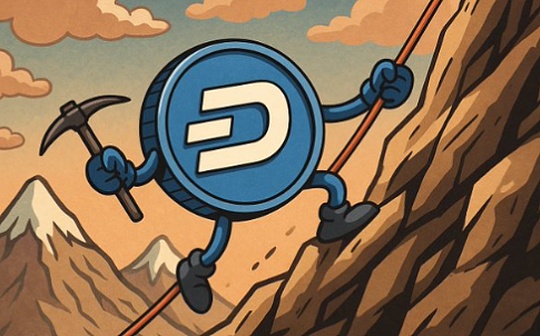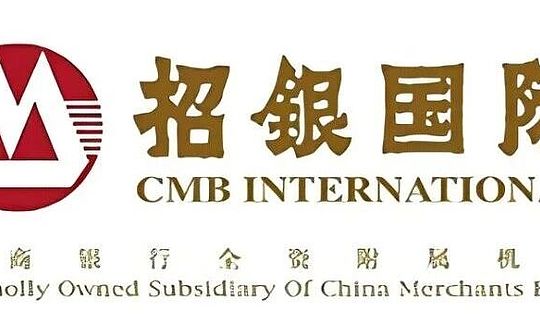
Author: Zhao Qirui, Source: RWA Research Institute
August 13, 2025 — CMBI Asset Management cooperates with DigiFT to launch a tokenized money market fund (MMF) in Singapore, which can instantly issue and redeeate token shares and launch online on Ethereum and Solana blockchain.
August 18, 2025 — China Merchants Bank International Securities Co., Ltd. has been approved by the Hong Kong Securities Regulatory Commission for virtual asset service provider license and has officially launched a cryptocurrency exchange/service for professional investors, allowing the trading of Bitcoin (BTC), Ethereum (ETH) and Tether (USDT).
August 18, 2025 — On the same day, China Merchants Bank International launched digital asset trading services, the first securities company with a bank background in China, providing transactions of the above three crypto assets within a regulated framework.
Chinese securities firms, which are calm in the eyes of the public, suddenly became stars in the RWA field.The most eye-catching thing is the series of actions of China Merchants Bank and its wholly-owned subsidiary China Merchants Bank International.In just one month, China Merchants Bank International has been making continuous moves, and after a closer look, we will find:
2025-07-14 / 2025-07 Mid-2025-07 — China Merchants Bank International was issued a license related to “virtual asset trading service” by the Hong Kong Securities Regulatory Commission, becoming one of the first Chinese bank-affiliated brokers to obtain such licenses, and has begun to deploy digital/crypto asset trading services for professional investors.
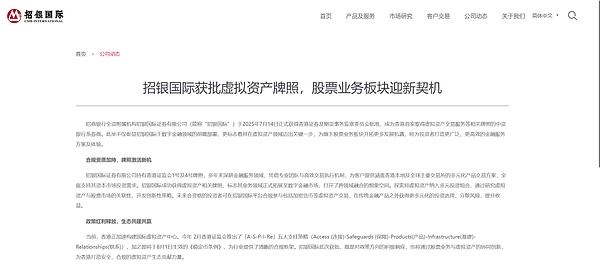
2025-08-09 — CMBI Asset Management cooperates with DigiFT, OnChain/Cactus Custody and others to complete the tokenization/on-chain distribution (RWA/tokenized fund) of its USD Money Market Fund (USD MMF), and promotes on-chain distribution and custody solutions on multiple chains (including Solana/Ethereum-related channels).This move is a representative case of public chain linkage and custody cooperation in Asia/Hong Kong.
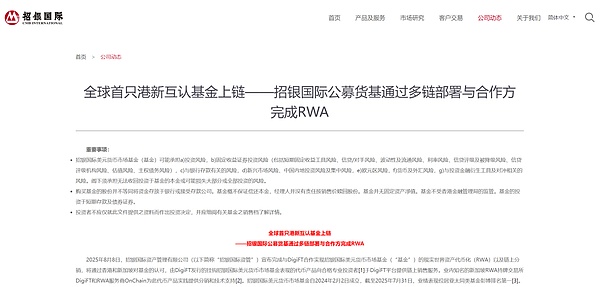
2025-08-18 — China Merchants Bank International announced and launched digital asset/cryptocurrency trading services for professional investors (including BTC, ETH, USDT, etc.), and there are reports that it provides related services as a brokerage company in Hong Kong (based on the regulatory license obtained).The company/industry media disclosed and interpreted this.
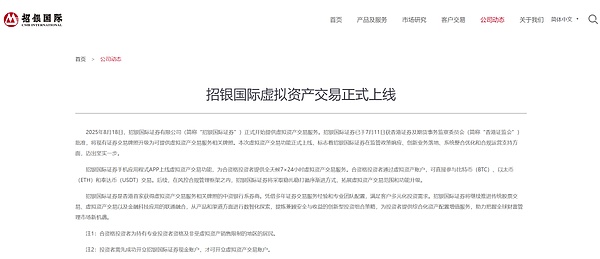
2025-09-02 — China Merchants Bank International helps Foton Investment Holdings issue “tokenized bonds” (now confirmed on the company’s official website), which reflects its business continuation and practice in the implementation of RWA/tokenized bonds.
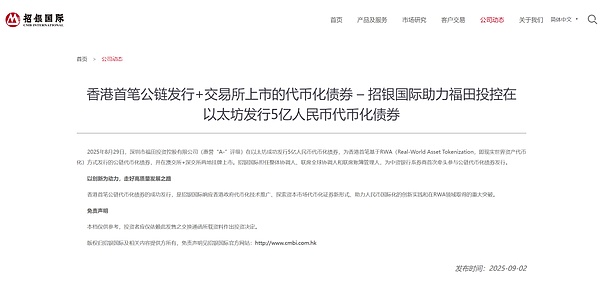
In early and mid-September 2025 — China Merchants Bank International won awards and rating recognition in wealth management and bond research/investment (for example, it was rated as the best wealth management agency in Hong Kong in 2025, etc.), and in mid-September, it assisted companies such as Hesai Group to complete the main listing/double listing arrangements of the Hong Kong Stock Exchange, showing the parallel advancement on both investment banking and wealth management.
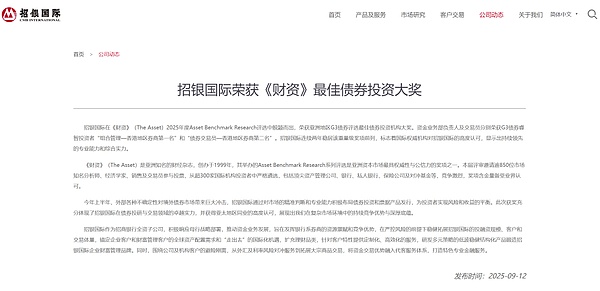
What is the reason why China Merchants Bank International keeps moving?How did China Merchants Bank International think?What is the impact of the China Merchants Bank International series of actions??
Prologue: The dual motivation driving the RWA layout of China Merchants Bank International
First of all, we must say that China Merchants Bank International’s recent actions in the real-world asset (RWA) tokenization field are more like a strategic choice induced by the dual internal and external pressures in the face of historical inevitability.To understand the deep logic of all subsequent actions, we must first understand the essence of this “dual task”: it is not only a defensive self-rescue of traditional finance in the profit red sea, but also an offensive exploration of state capital at the digital frontier.
Internal survival pressure: defensive choice under profit compression
First, it is the battle of survival originating from the internal one.The traditional financial industry, especially investment banking, is in a structural profit compression crisis.When the profit margins of traditional issuance and underwriting businesses are constantly eroded in the increasingly fierce competition, finding new growth points, improving operational efficiency, and reducing transaction costs, it evolves from strategic options to survival necessities.Against this background, RWA tokenization provides China Merchants Bank with its commitment to liberate asset liquidity, reduce trading frictions and expand its investor base, with a potential path to get out of the predicament.Transplanting traditional assets on blockchain is an attempt to open up a new battlefield of high efficiency and low friction at the edge of existing business models.It is this endogenous survival pressure that constitutes the most primitive and powerful driving force of its RWA strategy.
This survival instinct makes its outward exploration a necessity.Hong Kong, with its unique financial and legal ecology, has become a unique test site for this exploration.We analyzed it in previous articles.This is not a simple business decision, but a key move embedded in China’s grand chess game.As a broker with a national capital background, China Merchants Bank International’s exploration naturally brings a layer of “sending stones to ask for directions” for national strategies.Although its actions are likely to be spontaneous behavior of market entities under the clear regulatory framework of Hong Kong, rather than direct instructing from senior management, objectively, it is exploring a path for all Chinese institutions to comply with the West-led Web3 ecological compliance, and accumulating data and experience for the deeper digital financial layout in mainland China in the future.
External strategic exploration: Hong Kong as the “test field” of national strategy
However, it is this dual task of “insider survival” and “external exploration” that has given rise to a profound strategic contradiction.The RWA ecosystem promoted by China Merchants Bank International in Hong Kong, especially its fund tokens that support the redemption of US dollar stablecoins (such as USDC), is invisibly shaping and consolidating a “digital dollar zone” with the US dollar as the core in China’s sovereign territory.This poses a potential conflict with the Beijing-led digital RMB cross-border payment project (mBridge) aimed at challenging the hegemony of the US dollar and promoting the internationalization of the RMB.
This conflict is not a direct friction at the current business level, but a more profound geopolitical risk.Although China Merchants Bank International’s current decisions focus on business efficiency, its objective consequences are to add weight to the dominance of the US dollar in the digital finance world and form a potential hedge with the long-term goal of de-dollarization at the national level.This fundamental tension has begun to profoundly affect China Merchants Bank International’s strategic positioning, forcing it to achieve an extremely exquisite balance between business efficiency and national strategy when choosing a technical route and partners.It is here that we see that profound and irreconcilable crack:A structural fault line has already appeared between a “digital dollar zone” built by Chinese institutions and the huge parental national digital sovereignty behind it.
Chapter 1: Hong Kong’s regulatory environmentandStrategic positioning of market participants
China Merchants Bank International’s strategic deployment of RWA has undergone profound strategic calculations in its location in Hong Kong.The core logic is that only Hong Kong, a “rules connector” with the open capital market as its soul, can “domesticize” the emerging digital asset of RWA into traditional securities that are familiar to the market and regulated by existing laws.This is a distinction with Singapore’s regulatory philosophy. Although the latter established a licensing system for digital payment tokens (DPT), its orientation focuses more on wealth management and the security of payment systems. Some courts even ruled that cryptocurrencies are not recognized as currency.In contrast, the “penetration principle” of the Hong Kong Securities Regulatory Commission (SFC) – that is, to define regulatory boundaries based on the underlying economic essence of assets rather than their digital form – is the cornerstone of the establishment of this brilliant “rule arbitrage”.It enables China Merchants Bank International’s currency fund (CMBMINT), due to its “collective investment plan equity” nature, to be seamlessly incorporated into the existing framework of the Securities and Futures Ordinance (SFO).The “Circular on SFC-authorised funds with exposure to virtual assets” and the “Circular on Intermediary Institutions to engage in tokenized securities-related Activities” issued by SFC at the end of 2023 have paved the final path.
However, entering this arena requires an expensive “ticket”, that is, a tacit “compliance performance”.SFC imposes strict on-chain KYC/AML requirements on virtual asset service providers (VASPs), including comprehensive customer due diligence (CDD), ongoing transaction monitoring, suspicious transaction reporting mechanisms, and even the use of blockchain analytics tools.In addition, SFC requires highly reliable cold/isolated custody, complete CDD and continuous monitoring, and expects adequate insurance and compensation arrangements, which undoubtedly greatly raises the compliance threshold.The purpose of this performance is to qualify for on-site competition, but everyone knows that the real risk is hidden in the shadows that are not illuminated by the stage lights – the combination of RWA and the DeFi protocol itself has an inherent “mismatism”. DeFi’s permissionlessness makes it difficult to effectively block the inflow of non-compliant assets from risky addresses.In a rapidly iterative and partially anonymous Web3 environment, it is almost impossible to achieve the “zero tolerance” level of risk control in traditional finance.Once a sanctioned address interacts indirectly with CMBMINT through the DeFi protocol, China Merchants Bank International may face devastating regulatory penalties, including huge fines, license revocation and even criminal liability, with the risk of a collapse in reputation far exceeding any financial fines.
Strategic divisions between different market participants
It is in this unique arena that different players have staged their own strategic strategies based on the same set of rules and for completely different purposes, forming a complete market ecological map.
The core goal of Chinese securities firms represented by China Merchants Bank International, Guotai Junan International and Shengli Securities is to serve existing customers and revitalize high-quality assets at home and abroad.They are committed to connecting Hong Kong assets to global liquidity in a compliant manner, playing the role of a “clearance hub” and a “securitization engine”, trying to improve asset liquidity, reduce transaction costs and expand the scale of their own asset management business through blockchain technology.
Unlike Chinese securities companies that focus on revitalizing existing stocks and serving existing strategies, the chess game of foreign banks such as BlackRock and Franklin Templeton is even more ambitious.Their focus is not just to use the Hong Kong platform, but to promote its global digital asset platform and define global standards.By building universally applicable, institutional-level digital asset infrastructure—as demonstrated by Franklin Templeton and Wisdomtree’s U.S. Treasury tokenization experiments on Stellar chains—they intend to seamlessly integrate RWA products into the existing global financial system to solve the black box operation and high cost problems of traditional finance.They are using Hong Kong to stage a grand narrative about global standards.
In addition to the game between these two major forces, local Hong Kong institutions represented by DigiFT, HashKey Group and JD.com Coin Chain Technology have adopted more flexible strategies to deepen their efforts in specific niche markets.For example, DigiFT focuses on decentralized transactions of asset-backed tokens (STOs); HashKey Group, as a licensed VASP, dominates tokenized ETFs and public chain infrastructure; Shengli Securities has launched an RWA project for green energy battery-swap assets; while JD Coin Chain Technology has entered a stablecoin sandbox, focusing on the tokenization of stablecoins and new energy assets.These institutions seek to find their indispensable ecological niche in the ecosystem surrounded by giants by establishing barriers in specific asset classes or professional technical services.
In this game, cooperation and competition coexist.The establishment of organizations such as the Tokenization Industry Alliance (TAC) shows a win-win situation.However, this is undoubtedly a potential zero-sum game in competing for market share, defining industry standards and shaping regulatory directions.Large foreign banks with global network and technological advantages must compete with Chinese securities firms that focus more on connecting mainland China’s capital in the future in terms of market rules definition rights.The ultimate victory will depend on who can lead in technological innovation, compliance implementation and market scale, and win the trust and support of regulators.
Chapter 2: The tension between innovation impulse and institutional inertia
China Merchants Bank International’s layout in the RWA field is like the transformation of all behemoths. Its primary battlefield is not a rapidly changing external market or a complex regulatory maze, but a continuous game with its own organizational inertia hidden inside.Any attempt to graft crypto assets into traditional financial bodies will inevitably encounter deep institutional frictions from culture, risk control and IT architecture.For China Merchants Bank International, the real challenge stems from the structural tension between its innovation impulse and its own institutional gravity.
Positioning under the competitive landscape of Hong Kong market
By placing China Merchants Bank International in Hong Kong’s competitive landscape, its unique contradiction situation is becoming increasingly prominent.Backed by its parent company China Merchants Bank’s “innovation-driven” strategy and its emphasis on financial technology, China Merchants Bank International has cultural soil and organizational support for cutting-edge exploration.However, its distinctive market-oriented gene also means that when long-term and no significant profitable strategic investment is needed, opponents with stronger state-owned assets may lack the strategic determination and resource support of “patient capital”.
In contrast, securities firms with state-owned assets have stronger strategic task-driven and resource allocation capabilities in transformation, and can support long-term and non-profit strategic layout.For example, the China Financial Stability Report (2024) pointed out that the crypto asset license management system in Hong Kong, China has been listed, and large state-owned banks have also generally raised the strategic height of investment banking business and provided integrated services.However, the other side of this advantage is its inherent traditional brokerage culture and stronger administrative colors, which may bring more cumbersome internal approval processes and slower decision-making speeds, which is undoubtedly a heavy constraint in the ever-changing market.
At the same time, global foreign banks such as HSBC and Standard Chartered have shown a third form.Their complete global compliance framework and rich risk management experience are significant advantages in the extremely strict regulatory environment of Hong Kong SFC.But this globalized system has also become a double-edged sword on the specific battlefield of Hong Kong.Complex internal decision-making chains, the difficulty of cross-border regulatory coordination, and trade-offs on policies in different jurisdictions may make it far less flexible and efficient than locally-based institutions when responding to market changes and promoting innovation.Especially after the implementation of the Stablecoin Ordinance, the overall Hong Kong market entered the second half of the compliance stage, increasing compliance costs, which is a huge investment in global resource coordination for foreign banks.
Therefore, the success or failure of China Merchants Bank International’s exploration in RWA may not entirely depend on capital investment or technical selection.The deeper decisive factor is whether it can effectively manage and ultimately overcome this profound structural friction between pioneers and conservatives coexist within the same organization.
Chapter 3: Efficiency and Risk of SolanaEvaluation with hedging strategy
China Merchants Bank International deployed its US dollar money market fund on the Solana public chain. This move is not a purely technological selection, but a well-thought-out strategic compromise. Its essence is a business decision related to “niche” and “risk preferences”, rather than a product of technological idealism.
What is before decision makers is Solana’s huge attraction in operational efficiency.For potential high-frequency trading scenarios such as RWA, its claim to be up to ~65,000 TPS (the long-term actual measurement of the main network is significantly lower than this, usually in the range of thousands of TPS); the block time is about 0.39s; the conversion of simple transfers can be as low as ~$0.00025 when clicking the SOL price at several times, but the transaction fee will fluctuate significantly with the network load and the SOL exchange rate, forming an irrefutable “efficient solution”.These performance indicators have significant commercial value for improving the transaction efficiency of CMBMINT funds, reducing operating costs and achieving rapid settlement.This constitutes the “official narrative” of this strategic choice and is also the basis of its commercial argumentation.
However, the other side of this “efficient solution” is a series of structural vulnerabilities and historical baggages in the decision-maker’s risk books that need to be seriously evaluated.First of all, it has made a technical trade-off to the degree of decentralization. Currently, Solana’s network consensus is relatively robust.The second is its unstable historical record. Solana has experienced many major network outages, including two downtimes in 2022. For example, 2022-06-01 (about 4.5 hours of stagnation), there are official outage reports and media reports.For bank-affiliated brokers whose core competitiveness is trust and stability, this poses huge reputational risks and technical central counterparty risks.A long service interruption may not only result in direct and indirect losses of millions of dollars, but may also incur severe penalties imposed by the Hong Kong Securities Regulatory Commission (SFC) based on its strict VASP regulatory requirements (covering IT risk management, business continuity planning, etc.).Finally, its close connection with the FTX crash and the history of SBF being its main supporter have also laid it with extremely harmful negative labels such as “FTX Chain” and “Scam Bankman-Fried puppet”, which constitutes an unignorable reputation risk exposure.
Therefore, China Merchants Bank International’s choice should be regarded as a high-risk attempt to the future ecosystem.It not only chose Solana’s technology, but also bet on its DeFi ecosystem – a system with protocols such as Jupiter, Marinade, Jito, MarginFi and other systems with a total lock-in value of more than $4 billion – will continue to flourish in the future, thus providing rich application scenarios for RWA assets like CMBMINT.If the ecological development is less than expected, or an internal collapse similar to FTX occurs again, CMBMINT may become an “island” on the chain, and liquidity and utility will be greatly reduced.
Faced with these risks, China Merchants Bank International’s strategy includes clear active hedging behavior.It designed a precise “insurance strategy”: CMBMINT is the first product to support deployment on multiple public chains such as Solana, Ethereum, Arbitrum and Plume.This multi-chain deployment itself is a “Plan B” for single-chain risks.In its cooperation with technology service provider OnChain, the dual-standard architecture of Solana Token 2022 and SPL and the use of the “transfer hook” mechanism to balance compliance and efficiency, which shows that China Merchants Bank International has incorporated its understanding of Solana’s structural risks into the details of technology implementation.From a legal perspective, since CMBMINT’s compliance is rooted in the properties of its fund itself, rather than a specific blockchain, as long as the same compliance technical solution can be reproduced on other chains, its migration risks are relatively controllable.
By building a reference system for alternative routes, the exact position of China Merchants Bank International in the industry’s “risk preference spectrum” can be more clearly marked.The “orthodox” represented by BlackRock prefers to choose Ethereum and its L2 solutions.Although efficiency and cost are not superior, Ethereum’s stronger decentralization, security consensus and longer operating history are worth the sacrifice for global institutions that pay great attention to brand reputation.The “conservatives” with the lowest risk preference may choose alliance chains or private chains to eliminate public chain risks in a completely controllable environment, but the price is to become a technology “isolated island” that cannot enjoy the ecological liquidity and innovation vitality of the public chain.
China Merchants Bank International’s choice is an intermediate, high-risk and high-reward path.It neither chooses the closure of the alliance chain nor embraces the “orthodox” of Ethereum at any cost, but instead tries to achieve a delicate balance between efficiency and risk.Whether this “niche bet” can be successful will ultimately depend on the long-term development of Solana ecosystem and the effectiveness of China Merchants Bank International’s own multi-chain hedging strategy.
Conclusion
So far, we have surveyed the intersection itself where China Merchants Bank International is located.We deconstructed the internal and external driving forces behind the choice of RWA, the rules and ecology of Hong Kong’s unique arena, the profound institutional friction within the enterprise, and the ultimately precisely calculated risk trade-offs on the technical engine.We have seen how a pioneer enterprise took the first difficult step in the face of historical inevitability.
However, the true meaning of any path choice is not the moment of choice, but the unknown landforms and deep challenges encountered after embarking on the journey.When this token carrying traditional financial credit truly enters the ruthless world of code; when this pioneering action stirs up ripples throughout the industry; when this innovative model begins to backfire its own foundation – a larger and more cruel chess game has just begun.
How will the legal vacuum hidden deep in the code swallow the certainty of property rights?How will a pioneer’s breakthrough trigger an identity crisis that affects the entire Chinese securities industry?This will be the question we will answer in the next chapter.

